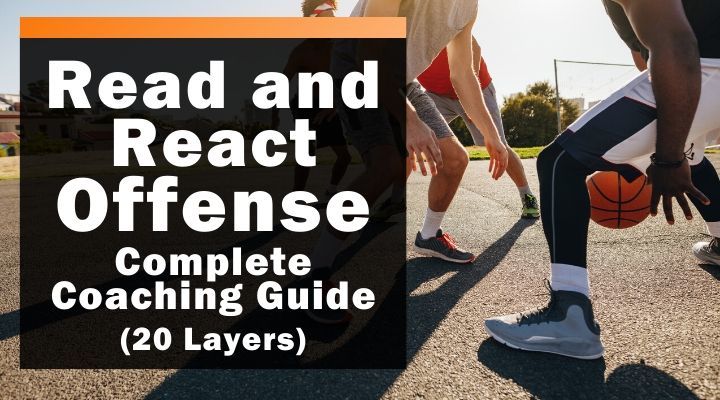
One of the best things a youth or high school coach can do is build continuity throughout his or her basketball program.
When players grow up learning the same system, terminology, and skill progressions, they are more likely to be successful as high schoolers.
Coach Rick Torbett from Better Basketball has developed an innovative offensive system that is a perfect choice as a program offense.
The beauty of the Read and React offense is that it is taught in layers.
This means that young players can play out of a few simple concepts which will build and become more complex as they gain experience.
If you’re a high school coach looking for a system that can be introduced at the youth level and expanded upon in middle school and high school, the Read and React may be for you.
If you’re a youth or middle school coach whose high school program does not use the Read and React, you may still want to consider it because it allows players to play and builds basketball IQ.
Strengths of the Read and React Offense:
a. Highly Versatile System
You can use the Read and React with any type of team.
Torbett’s offense can be run out of 3-out, 4-out, or 5-out alignments.
This makes it easy to run the same offense but adapt it to your personnel year to year.
This continuity is a huge advantage over teams who have to overhaul their offense every time their personnel changes.
b. Builds Over Time
This is what makes the Read and React offense unique.
Young teams can begin with a few simple layers.
Each year another one or two can be added, until the offense has a multitude of options.
The Read and React can be effective at the youth level with those early layers, but can be extremely hard to defend with a varsity team well-versed in the nuances of the system.
c. Customize to Fit Your Team
Although Torbett has numbered the layers, no team needs to use all of them and you don’t necessarily need to teach them in order.
This means that coaches can choose the layers that fit their philosophy and their team.
However, it’s important to master one layer before adding another.
d. Teaches Players to Play Without the Ball
You frequently hear coaches comment that playing without the basketball is a lost art.
In the Read and React, the player with the ball initiates the action, while the other four players must react to the ball handler.
These movements without the ball are crucial to the success of the offense and must be drilled regularly.
The end result is having a team of players who can play with or without the basketball.
e. Forces Defenses to Guard Constant Movement
In the Read and React, players are constantly cutting and screening.
This movement is difficult to defend.
Because Read and React is a motion offense, it is hard to predict the next movement, which makes it hard to scout and guard against.
f. Good Skill Development Offense
This is an offense that teaches players to play the game.
To do that effectively, players must develop skills within the offense.
There are a number of breakdown drills for the Read and React that incorporate shooting, passing, and finishing skills.
By using these drills each practice, your team will learn the habits and concepts of the offense but will also improve its fundamental skills.
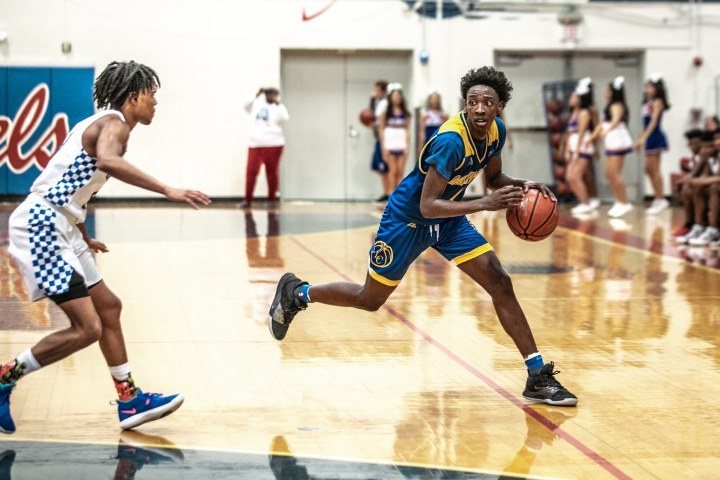
Weaknesses of the Read and React Offense:
a. Requires Patience
Coaches choosing the Read and React should be aware that it will take time to master.
Players must master one layer before moving on to the next, and that may not be a fast process, particularly for beginning players.
However, the benefit of this approach is that the offense will build and progress over time.
b. Must Fully Commit for it to be Successful
If you’re a coach who wants to run 15 set plays in addition to your primary offense, the Read and React may not be for you.
Much of your practice time will need to be invested in building the habits of this offense.
If you decide to install a bunch of sets the first time the Read and React doesn’t work, you will likely never build mastery in your players.
Again, a great deal of patience is required.
c. Your Best Players May Not Get the Most Shots
As with any motion offense, in the Read and React, all players should get touches.
This is great because it keeps everyone involved in the action.
However, you still want to make sure your best players get the most shot attempts.
Coaches must communicate roles to players so that all players understand the shots the team is looking for.
The 20 Read and React Layers:
The Read and React offense consists of 20 layers.
While this may seem overwhelming, it is important to remember that coaches can pick and choose which layers best fit their team.
Very few teams will incorporate all 20 layers.
The diagrams below show the layers out of a 5-out alignment, but you can use 4-out or 3-out alignments with your team, or you can move from one to the other based on your opponent or who is in the game.
Layer #1 – Pass and Cut
This layer is the foundation of the entire offense.
After passing to a perimeter player one pass away, the passer must cut hard to the basket.
Torbett emphasizes that every cut should be a scoring cut.
Cutters should finish their cuts at the rim.
The second part of this layer is perimeter players filling the open spot when one is vacated above them.
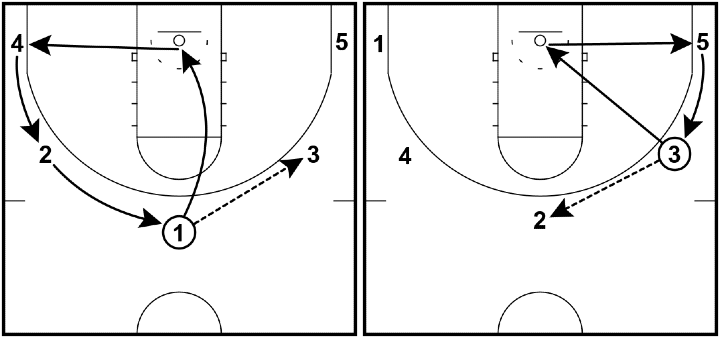
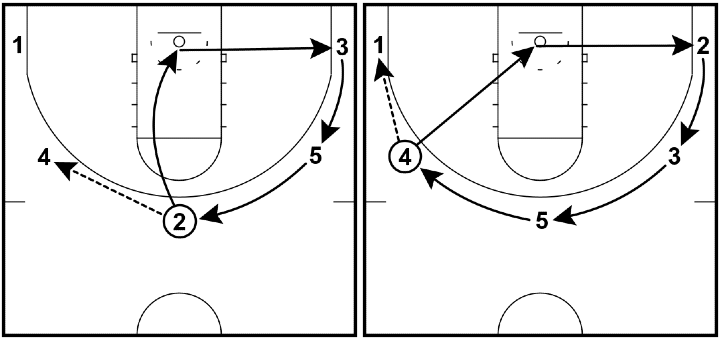
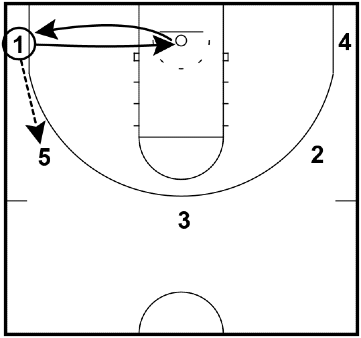
Layer #2 – Post Pass and Cut
When the ball is passed to the low post, the rule stays consistent with Layer #1.
The passer cuts to the basket.
He or she has two choices:
“Laker cut” low or high.
Remind cutters to cut in a way that gives the post player room to operate.
The first diagram below shows a low Laker cut, and the second diagram demonstrates a high Laker cut.
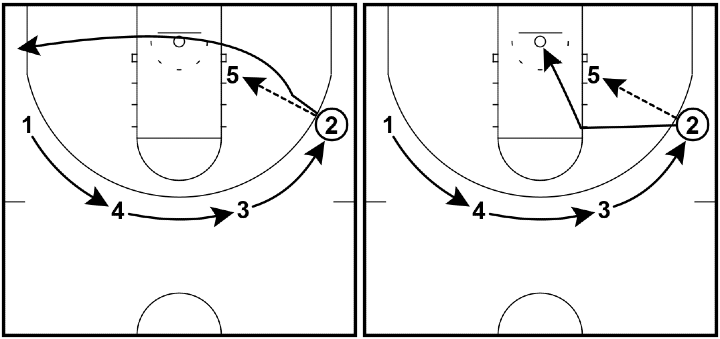
Layer #3 – Dribble At Back Cuts
The next layer of the offense teaches players what to do when a teammate dribbles at them.
In the Read and React, a dribble at triggers a backdoor cut.
The same fill rule applies – fill an open spot above you when there is one available.
Note that this is different than dribble penetration to the basket.
This layer only applies when the ball handler dribbles at a teammate.
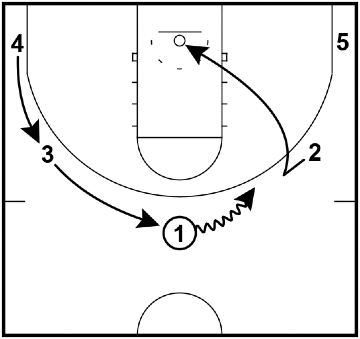
Layer #4 – Circle Movement on Dribble Penetration
This layer may take a bit longer to master.
When a ball handler drives to the basket, the other perimeter players are instructed to move in the direction of the drive.
On a drive to the right, everyone moves to the right.
On a drive to the left, everyone moves left.
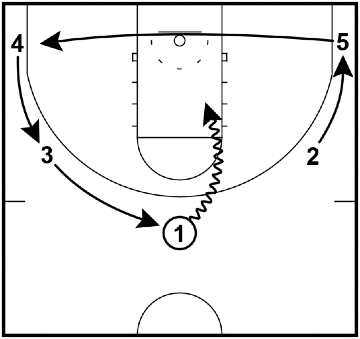
Layer #5 – Post Reaction on Penetration
In the Read and React, post players (if you choose to use them) can be stationed on the ball side or weak side of the floor.
Their reads on dribble penetration are the same regardless of which of these options you choose.
If the ball is driven above the post player, he or she slides to the short corner.
If the ball is driven from the baseline, the post player slides up toward the elbow.
The goal of both of these actions is to maximize space for the ball handler and free up the post player for an open shot if their defender helps.
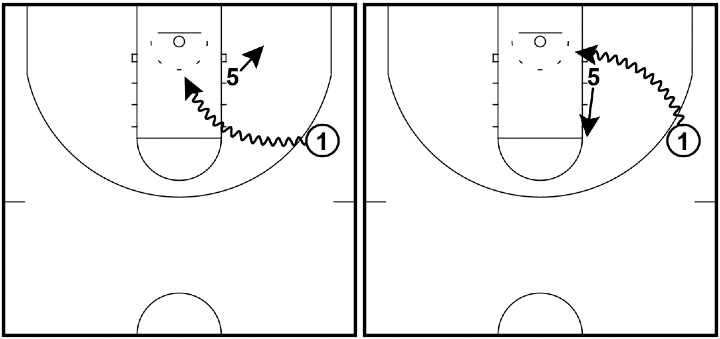
Layer #6 – Baseline Penetration
In the Read and React, baseline drives are treated differently than other drives.
Drivers along the baseline need a passing option in the weak side corner, so the closest player to that corner must “drift” all the way down.
Other perimeter players execute their typical circle movements.
Layers 5 and 6 are combined in the diagram below.
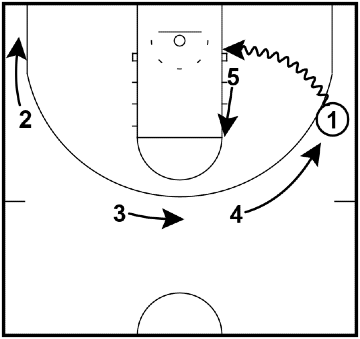
Layer #7 - Pin and Skip
This layer is frequently used against zone defenses, but can be very effective versus man-to-man as well.
Weak side players execute a pin screen if they see a teammate’s defender jumping to the ball in help position.
The goal of a pin screen is to free up the cutter for a shot or to post-up the screener after the screen.
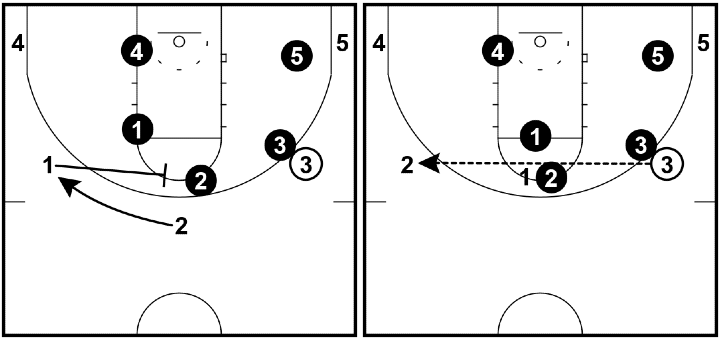
Layer #8 – Circle Reverse
This layer gives the offense a pressure release option when a ball handler picks up his or her dribble.
On the drive, players follow the circle movement rule.
However, if the dribble becomes dead and no pass is immediately available, the perimeter players reverse the circle movement by moving in the opposite direction.
The circle reverse layer helps teams limit turnovers and can lead to some backdoor layups.
The first diagram below shows circle movement, and the second shows circle reverse cuts.
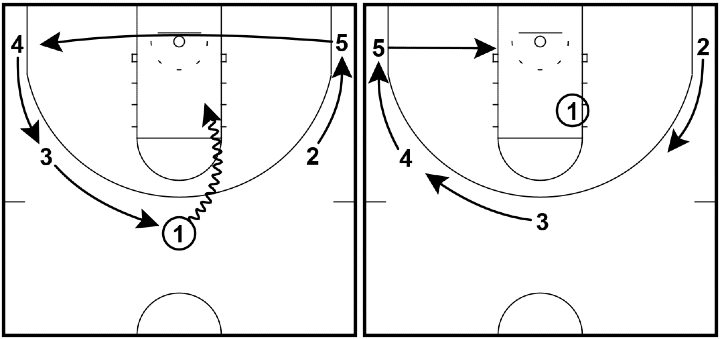
Layer #9 – Post Screens
This layer is good for teams running Read and React from a 4-out alignment.
Post players have the option of stepping away from the basket to set back screens for perimeter players.
After screening, the post player should come back to the ball, ready to receive a pass.
These back screens could be set at different angles.
The diagram below shows the post setting a flex screen on the baseline.
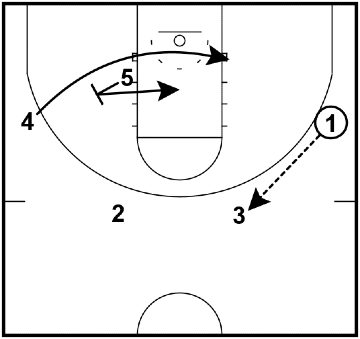
Layer #10 – Back Screens
This layer is an extension of Layer #1.
The foundation of the Read and React is a basket cut after each pass.
If you install Layer #10, players will set a back screen for a teammate after basket cutting.
Cutters can screen for any perimeter teammate, which adds some randomness to the offense.
Teach players that by setting good back screens, they will free themselves for open jump shots.
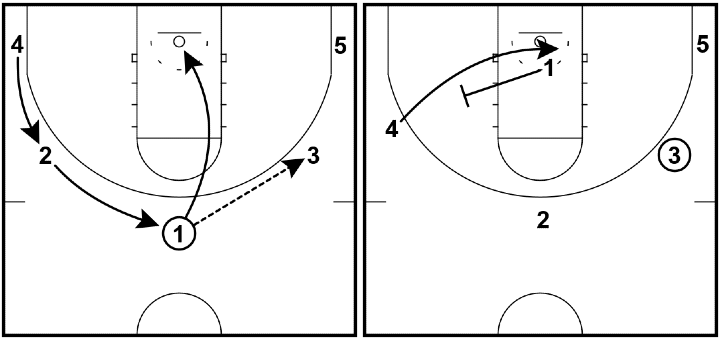
Layer #11 – Staggered Screens
This layer happens when two actions occur consecutively.
In the diagrams below, Player 1 passes, cuts, and sets a back screen for Player 4.
As this action occurs, Player 2 passes to Player 3 and begins his or her cut.
As the cut happens, Player 4 is coming off the back screen.
Player 2 sets a screen for Player 4, turning the back screen into a staggered screen.
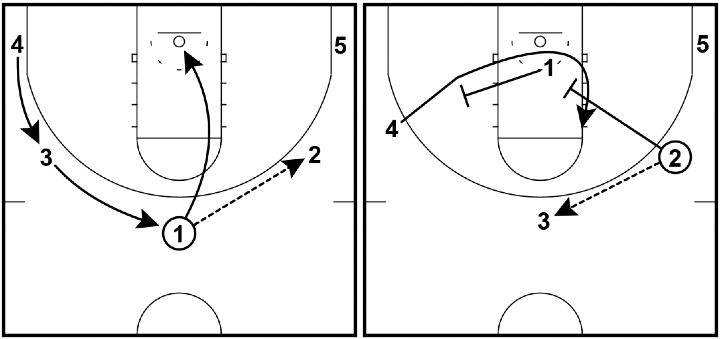
Layer #12 – Ball Screens
When a ball handler reverses their dribble away from the basket, it signals a ball screen set by the post player.
This is a subtle way of adding random ball screens to your offense.
Circle movement still happens if the ball handler drives the ball off the ball screen.
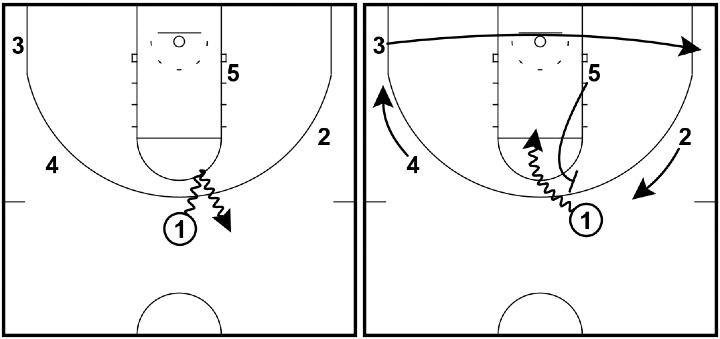
Layer #13 – Post Pass and East / West Cut
This layer provides some alternatives to the basic post pass and cut taught in Layer #2.
There are two ways to make east/west cuts after making a post entry pass.
The first is to simply relocate to another perimeter spot.
The second is to “X-Cut.”
Execute an X-cut by screening for the nearest perimeter player, then cutting to the basket.
The first diagram below shows a relocation, and the second shows an X-Cut.
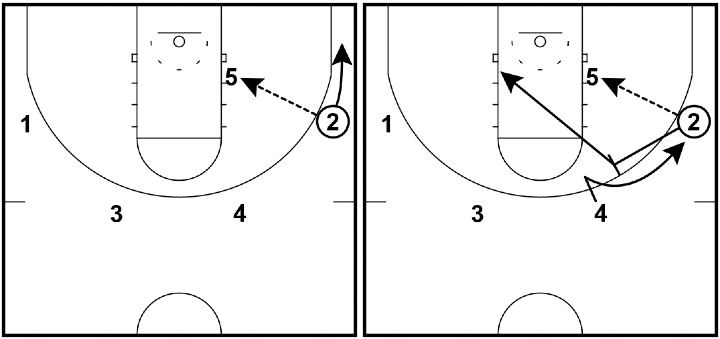
Layer #14 – Corner (Pass and Cut)
This layer is a counter to how the defense may guard your basket cuts.
If a defender bumps your cut by getting chest-to-chest, making it difficult to finish the cut at the rim, it is best to abandon the cut.
Torbett gives two suggestions in this scenario.
The first is setting a back screen – this is Layer #10.
The second option is simply cutting out to an empty spot.
Torbett calls this “corner” because the cut makes a corner with the attempt at a basket cut and the fill to the empty position.
The back screen option was already shown in Layer #10, so the diagram below shows the corner option.
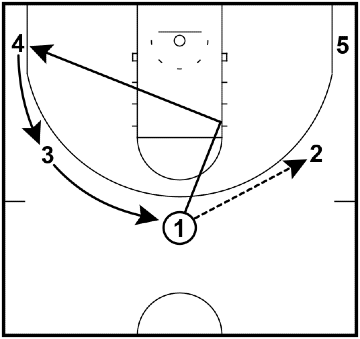
Layer #15 – Power Dribble
The power dribble is an action that triggers a dribble handoff.
The ball handler will dribble at a teammate, but begin to turn his or her back to signal a handoff rather than a backdoor cut.
The original ball handler can roll to the basket and the other perimeter players will execute circle movement.
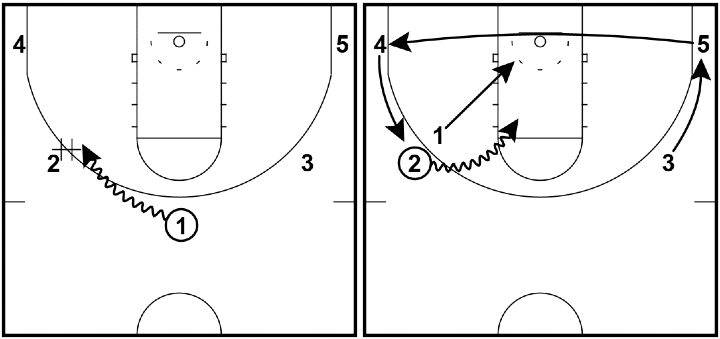
Layer #16 – Advanced Post Reactions
This is an extension of Layer #5.
That layer stated that post players should step to the short corner on drives that happen above them.
This layer teaches the player in the short corner to backdoor cut if their defender steps out with them to deny them the ball.
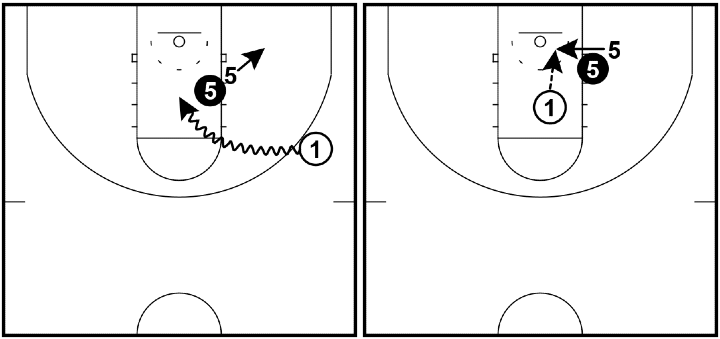
Layer #17 – Transition Offense
The last four layers of the Read and React offense are supplemental layers.
These are more conceptual than specific actions.
The first of these is transition offense.
The offense wants to seamlessly flow from transition offense to half court offense.
Create an advantage in transition and maintain that advantage throughout the possession without giving the defense a chance to catch up.
Layer #18 – Press Break
This layer encourages coaches to view half court and full court offense the same way.
A press can be attacked by using the pass and cut and dribble-at concepts.
These rules help to create consistency and lets players just play “offense,” regardless of their position on the floor.
Layer #19 – Full Court Trips
This concept also focuses on flowing from the full court to the half court.
Torbett drills this by running transition cycles 5 on 0, then adding one defender at a time to force the offense to make decisions.
The drill progresses from 5 on 0 to 5 on 1, 5 on 2, 5 on 3, 5 on 4, and 5 on 5.
Layer #20 – Flowing Naturally from Set to Set
When a team has mastered the Read and React offense, it can flow from one layer to the next, from full court to half court offense.
A team that achieves this goal will play together beautifully and be extremely difficult to guard.
Want to Learn More?
To find out more about this innovative system, make sure you check out the Read and React Offense over at Better Basketball.
